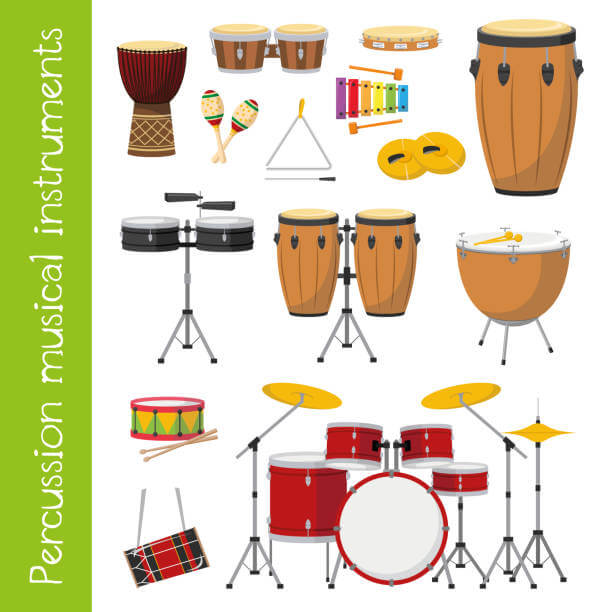Percussion Instruments
 Percussion instruments include any instrument that makes a sound when it is hit, shaken, or scraped. It's not easy to be a percussionist because it takes a lot of practice to hit an instrument with the right amount of strength, in the right place and at the right time. Some percussion instruments are tuned and can sound different notes, like the xylophone, timpani or piano, and some are untuned with no definite pitch, like the bass drum, cymbals or castanets. Percussion instruments keep the rhythm, make special sounds and add excitement and color. Unlike most of the other players in the orchestra, a percussionist will usually play many different instruments in one piece of music. The most common percussion instruments in the orchestra include the timpani, xylophone, cymbals, triangle, snare drum, bass drum, tambourine, maracas, gongs, chimes, celesta, and piano.
Percussion instruments include any instrument that makes a sound when it is hit, shaken, or scraped. It's not easy to be a percussionist because it takes a lot of practice to hit an instrument with the right amount of strength, in the right place and at the right time. Some percussion instruments are tuned and can sound different notes, like the xylophone, timpani or piano, and some are untuned with no definite pitch, like the bass drum, cymbals or castanets. Percussion instruments keep the rhythm, make special sounds and add excitement and color. Unlike most of the other players in the orchestra, a percussionist will usually play many different instruments in one piece of music. The most common percussion instruments in the orchestra include the timpani, xylophone, cymbals, triangle, snare drum, bass drum, tambourine, maracas, gongs, chimes, celesta, and piano.
The term percussion instrument refers to the fact that most idiophones and membranophones are sounded by being struck, although other playing methods include rubbing, shaking, plucking, and scraping. Although many idiophones and some membranophones are tunable and hence may be melody instruments, both groups serve typically to delineate or emphasize rhythm. Percussion instruments form the third section of the modern Western orchestra, stringed and wind instruments making up the other two sections.
When it comes to percussion instruments, most people tend to think of the drum. However, there are different types of percussion instruments from different parts of the world. Examples of percussion instruments include sticks, shakers, tambourines, maracas, xylophones, blocks, and bells.
Types
- Idiophone Instruments
- Membranophone Instruments
Idiophone Instruments
Idiophones form a diverse and disparate group. Concussion instruments, consisting of two similar components struck together, include clappers, concussion stones, castanets, and cymbals. Percussion idiophones, instruments struck by a nonsonorous striker, form a large subgroup, including triangles and simple percussion sticks; percussion beams, such as the semanterion; percussion disks and plaques, single and in sets; xylophones, lithophones (sonorous stones), and metallophones (sets of tuned metal bars); percussion tubes, such as stamping tubes, slit drums, and tubular chimes; and percussion vessels varying from struck gourds and pots to gongs, kettle gongs, steel drums, bells, and musical cups.
Membranophone Instruments
Musical instruments in which the sound-producing medium is a vibrating membrane fall into four main groups: kettledrums and bowl-shaped drums; tubular drums—whether cylindrical, barrel, conical, double conical, hourglass, goblet, or shallow—and rattle drums, the membranes of which are set in motion by enclosed pellets or by knotted ends of a thong or cord; friction drums, with membranes caused to vibrate by friction; and mirlitons, whose membranes are set in motion by the sound of an instrument or the human voice. Strictly speaking, mirlitons are voice modifiers rather than true musical instruments inasmuch as they have no pitch of their own.
List of Percussion instruments